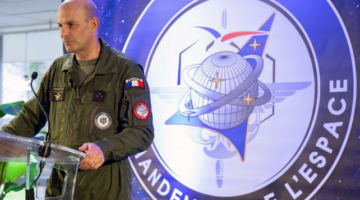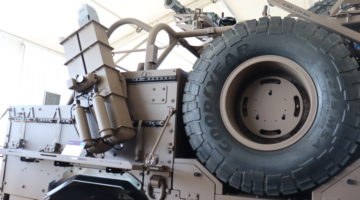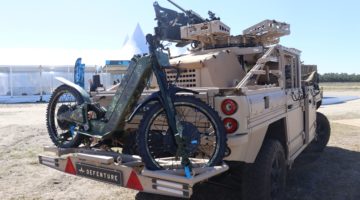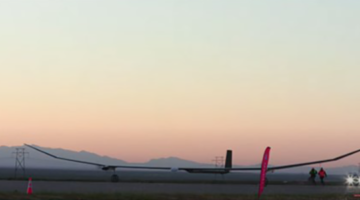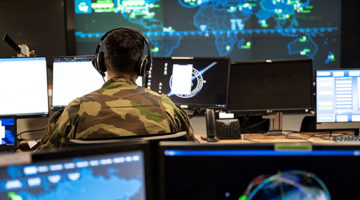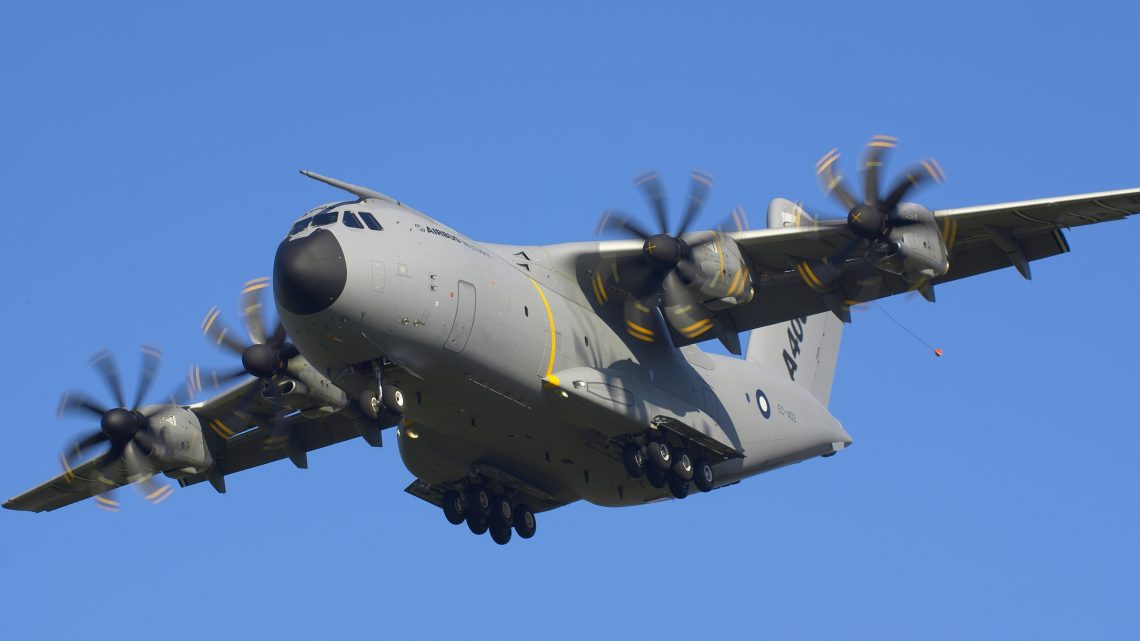Photo credit © French Air Force
The French Air Force has activated its first 400M squadron.
And it did not take much time for the new plane to be put to operational use.
The A400M in the past months has been involved in various theater missions for Operations Barkhane in the Sahelo-Saharan zone and Chammal against ISIS.
While a lot of tactical capabilities remain in the process of completion, the French Air Force has been able to start using its recently acquired airlifters for logistic missions only a few months after acquiring them.
Behind this ability lies a strong will and a vision to build on solid foundations with across the board fleet and lessons learned in mind, jointness and interoperability as a goal, and MRO set as the first milestone.
Last June, at the Orléans-Bricy Air Base, the French Chief of Staff of the Air Force, General Denis Mercier, participated in the 20th anniversary of French Air Force Special Forces (CPA for “Commandos Parachutistes de l’Air “).
In the background was the Atlas (A400M) surrounded on each side – like a pair of old parents – by two 40-something tactical aircrafts: one Transall (C-160) and one Hercules (C-130).
Symbolic of the transition between two generations, the central presence of the A400M marks a new era in the history of the FAF (French Air Force).
“A strategic airlifter with tactical capabilities” is the way Lieutenant-Colonel Paul Creuset, who was at the time in charge of setting up the future A400M squadrons, describes this new bird which France has been acquiring at a steady rate since August 2013.
By the end of 2014, the sixth one will be joining the forces with a delivery schedule of fifty aircraft by 2022.
The A400M is central to the success of French XXIst Century power projection strategy as most of its current fleet acquired since the 60’s is progressively being retired.
France’s stated goal in the 2008 White Paper was already to shift from the previous goal of being able to deploy an autonomous rapid projection force of 1,500 troops in 72 hours at a distance of 5,000 kilometers to the new one of being able to deploy1,500 troops in 5 days at a maximum distance of 8,000 kilometers.
To do this requires an ability to airlift up to 5,000 tons of equipment, but according to the French Senate at the time of a report done in 2009, only 20% of that objective was then reachable given the French airlift capability in the fleet and it was noted in the report that it would take 15 years to build up that capability.
It Takes Time
But change takes time.
About the same number of years has been necessary to initiate the ongoing process of transforming into reality the A400M tactical and logistical capabilities defined in the 2003 notification contract between Airbus Military and OCCAr (“Organisation conjointe de coopération en matière d’armement“), the organization representing the nations participating to the program and ensuring the qualification process (i.e. Belgium, France, Germany, Luxemburg, Spain, Turkey and the United Kingdom).
“The manufacturer must demonstrate – sometimes with the help of nations committed to supply the necessary equipment for testing such a helicopter or a tanker – that the aircraft “is capable of”: it is its responsibility to find the technical solution allowing a designed capability, whether airdropping, tough airfield landing, resisting to high or extremely temperatures, etc. Once the capability has been demonstrated, it is verified by OCCAr and then, signed and transferred to the nations. Once the aircraft is considered apt, each nation can then start experimenting ”, explains Lieutenant-Colonel Creuset.
Creuset has been in charge of precisely that process of experimentation as the head of the Multinational Entry to Service Team (MEST) set up a few years ago by the FAF on a temporary basis in order to ease and optimize the A400M entry into service.
Notably, on September 17th, in another official ceremony held in presence of General Mercier at Orléans, which is the mother base of the new transport aircraft, the MEST gave birth to the first A400M operational transport squadron, the ET 1/61 « Touraine » (Escadron de transport).
But not only: attached to the Mont-de-Marsan-based Center for military air experimentation (CEAM for “Centre d’expérience aérienne militaire”), the MEST has been designed to experiment as the end-user and was from the very beginning set up in four pillars pre-shadowing the structure officially born last month :
- The embryo of the operational Squadron, which had been mothballed for two years while awaiting the arrival of the A400M ;
- A Joint Evaluation Team (JET) meant to conduct experimentation with pilots and maintainers, now the EMATT (“Equipe de marque avions de transport tactique”) ;
- A training branch now merged with the Air Force Command instruction center for transport personnel (CIET for “Centre d’instruction des équipages de transport”) ;
- A unit in charge of digital data recollection dedicated to mission preparedness, the CESAM (“Centre de soutien et d’administration des systems missions”).
“This latter concept comes from commercial airlines best practices, but is also a fundamental lesson learned from the FAF experience with the Rafale fighter,” notes Lieutenant-Colonel Creuset.
Building a Dream Team : Building on Solid Ground
The approach chosen by the FAF has been to pull all lessons learned from every single experience possible, whether French of international, as part of the strategy of innovation elaborated by its Chief, General Mercier in a 2013 interview :
“In order to encourage a bright new look and a spirit of innovation, we need to encourage (…) the development of crossed paths: this is what we already do with the A400M, for which the entry in service unit includes technical staff coming from the Transall, the Hercules, the Airbus fleet, but also from Rafale.”
Cross-fertilization with the Rafale experience makes sense for several reasons:
The technology of the A400M – especially its fly-by-wire system – allows it to perform in terms of acceleration and maneuverability in a similar way to a jet fighter, a capability noted by the A400M the test pilots. Former FAF fighter pilot and now Airbus Chief of testing Eric Isorce says “the A400M conducts itself like a fighter: it is like flying a big fighter!
Also, new tactical innovations can occur with a strategic-tactical aircraft which ought to bring new concepts of operations, something which Orléans is a center of excellence for the FAF.
The human-machine interface and the constant dialogue allowed by computer-assisted breakdown diagnostic is common to these new-generation aircraft with the advantages, but also all the challenges these new tools bring :
“At the MEST, we have been developing processes to reinject post-flight data analysis, so there is an intelligent breakdown management: before, all information would go to the pilot without discrimination. (…)
We now try not to overwhelm the pilot with an overload of minor information and our role is to learn the system and check for its accuracy”, explains Lieutenant-Colonel Baron, who is part of the implementing team at Orléans.
Easing the task of the pilot is all the more important these days as, with multirole aircrafts such as the Rafale or the A400M, come multitasking and multimission demand sets.
The MEST therefore capitalizes on the experience of FAF pilots already accustomed to the Airbus philosophy, whether via the A340 of the Transport Squadron Esterel or via learning on the new simulators which are the same as the A380s, to incorporate new habits in a transport community used to the traditional C160s and C130s, for which flying required the full attention of the pilot.
As Lieutenant-Colonel Baron noted, in an interview: “The A400M will feel vibrations, air masses, solicitations, which it will constantly integrate without being noticed by the pilot so that the structure is the less worn out as possible.”
As the MEST team experimented with the Atlas and pushed its real capabilities to further understand all its potential and/or limits, one of the many questions raised early on has been what kind of crew would fit best and what kind of training might be most appropriate to that crew. In particular the question of the third man added to a two-pilot crew was debated and cross-fertilization in this case has also been done internationally.
Major Christophe Piubeni, MEST’s Head of Training Branch, recalls: “given the increased capabilities available on the A400M, we have been exploring the US concept of tactical system officer, [while] the coming of Link 16 and satellite communications could generate the need for a communication specialist.”
Conceived to be the cornerstone of a joint European transport capability, common ConOps, norms and interoperability with allies have indeed been at the heart of the MEST’s efforts, especially with the UK.
Some of the MEST pilots, such as Lieutenant-Colonel Luneau, have been exchange officers on British C130J considered by a pilot as “half-way between the C130H and the A400M”: “we have a lot to learn from the British, in terms of lessons learned from Iraq and Afghanistan, but also through their daily MRTT and C17 missions”, he is quoted as saying in the FAF magazine Air Actualités.
Last June, six British personnel worked in the MEST, but also one German pilot: “This pilot is here to work with us on training, while I formed three French officers now in Germany, as the goal is to have all our French A400M maintainers trained in Germany,” explained Lieutenant-Colonel Creuset at the time.
Orléans is to be the tactical training center and Wunstorf will become the logistic training center.
Wunstorf is initially one of the three German Transall bases, the Transall having been conceived as a replacement for the Nord-Atlas (hence the name Atlas, the grand-son of the former) with a first flight in 1963 and as the “Alliance Transport” aircraft (Transall comes from the name « Transport de l’Alliance »).
As the years went by, France and Germany diverged on the use of the aircraft rendering difficult any common maintenance cooperation.
That is where the coming of the A400M and a tailored evolution of the European Air Transport Command (EATC) come into plays to try to alleviate such a drift among allies and allow a common policy in terms of spares, maintainers training and so on.
Put in other terms, the EATC and the A400M can well become mutually reinforcers of capabilities operationally at both the command and operational levels.
The other major change, which comes with the A400M, concerns precisely the MRO (Maintenance, Repair & Overhaul) side of the story.
The Chief of staff of the FAF wanted to ensure that “activity pulls MRO and not the other way around, MRO being at the heart of activity. (…) It is essential that MRO follows and it will be the case with the A400M.” [ref]2012 Interview, Paris[/ref]
This means not only testing the aircraft, but also all the tools and equipment necessary to maintain it: a complex task as well.
In addition, setting up a robust logistic system for the Atlas has been for the MEST a core objective and foundational goal, as training (both real and with new top of the line simulators), processes and live experimentation on equipment have kept the team rather busy in the run up to standing up the first A400M squadron.
To do this MEST worked closely with Airbus, as the aircraft’s capabilities compared to the C130s and C160s are very different and allow multiple troop-equipment combinations.
Real-life experimentation has been done in connection with the French acquisition agency DGA (“Direction générale de l’armement), the Army and sometimes other manufacturers. This was, for instance, how the FAF worked the task of learning how best to load and unload the 29 tons armed vehicle VBCI for the first time last year from the aircraft.
Following Airbus Sevilla’s training center’s lead, Orléans has very early on built all the necessary infrastructure to accompany the building of an A400M fleet and to train the future crews thanks to state of the art simulation and e-learning tools.
As Major Piubeni notes, “before, all training was entirely manual ; today we do not have the means, time or resources to go train to load a VBCI [away from the base] and our new loadmaster simulator allows us to get prepared to face all kinds of contingencies.”
In other words, being able to deploy and use the aircraft, is not just about the aircraft but the sytems which enable it as well.
And here the FAF is working hard on shaping the overall airlift system.
The A400M is therefore not perceived by the French military as a “Transall Plus” and the stakes are high to succeed this transition in a new era for the FAF.
“The Atlas is not simply an upgraded Transall ,“ says Lieutenant-Colonel Creuset. “If fifty years of experience with the C160 and the C130 have allowed us to know each single screw of these planes, we are in an experimental phase with the A400M.”
This “experimental phase” has included rewriting the processes, organization, ConOps on a national basis, but also internationally, in close connection with new navigability requirements and the ongoing complex process of certification and qualification.
Over the past years, the latter has been implemented, and is still being implemented, capability by capability, by the constructor and system integrator, Airbus Defence & Space, the OCCAr countries as well as Malaysia, another customer nation.
But this is just the beginning of setting in motion a new airlift enterprise for the FAF and other A400M users.
This article is in part based on a series of interviews conducted over the past months, which will be published on their own in the coming weeks.


